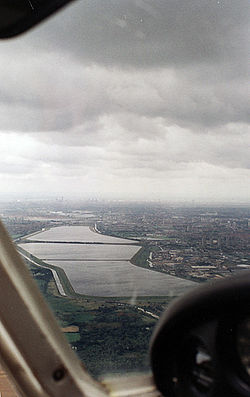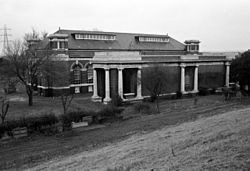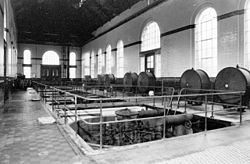King George V Reservoir
The King George V Reservoir, also known as King George's Reservoir, is is part of the Lee Valley Reservoir Chain on the borders of Middlesex and Essex that supplies London with drinking water. The storage reservoir is bordered by Sewardstone and Chingford in Essex to the east and Brimsdown and Ponders End in Middlesex to the west, and covers 420 acres, making it the largest in London.[1] The reservoir and the nearby William Girling Reservoir are known collectively as the Chingford Reservoirs, and are owned and managed by Thames Water.
Contents
History

The reservoir was conceived as part of an overall plan for the Lea Valley and was laid before the Royal Commission on Water Supply (Balfour Committee) in 1893. At this time the responsible authority was the East London Waterworks Company. However, under the Provisions of the Metropolis Water Act of 1902, the undertakings of this as well as seven other companies were transferred to the Metropolitan Water Board.
Construction was started in 1908 and completed in 1912. The reservoir was opened by H.M. King George V in 1913, hence the name.
The Metropolitan Water Board operated the reservoir until the Board was abolished in 1974 under the provisions of the Water Act 1973 (c. 37) and ownership and control transferred to the Thames Water Authority. Under the provisions of the Water Act 1989 (c. 15) the Thames Water Authority was privatised as Thames Water.
Description
The reservoir was formed by the construction of a continuous embankment on the floodplain of the River Lea at Chingford. An earth embankment divides the reservoir into two compartments that are connected by three large diameter culverts. The external grassed embankment consists of a central puddle-clay core with shoulder filling comprising a mixture of river terraced gravels and alluvial deposits.
The reservoir embankment has a puddle-clay core extending down into the underlying London Clay and gravel/earth shoulders at a slope of 1 in 3. The top of the embankment is 33 ft above the surrounding land. The key engineering parameters are:[2]
| Parameter | Value |
|---|---|
| Maximum embankment height | 33 ft |
| Length of Embankment | Four miles |
| Total capacity | 16,200 cubic yards |
| Surface area | 535 acres |
| Inflow capacity | 490 cu. yd/d |
| Emergency drawdown | 3 ft 4 in within 24hrs |
Located in the north-west corner is the original inlet pumping station by W.B. Bryan and finished in red brick and Portland stone. Still in situ are three of the five gas-fuelled liquid-piston pumps designed by H. A. Humphrey. In 1970 these were made redundant by the installation of a vertical spindle electric pump.[3]
The emergency drawdown rate (the rate at which the water level in the reservoir can be reduced) was about 1 ft 2 in/day.[2] Inspections in 2005-07 identified that this was inadequate, and proposed that the drawdown should be 3 ft 4 in/d as defined in the provisions of the Reservoirs Act 1975 (c.23).[4] This was achieved by installing twin four-foot-diameter siphon pipes over the embankment.[2] The valves controlling the outflow are 26 ft high and have a flow capacity of 9 cu. yd/s.[5] The siphons are located in the south-east corner of the reservoir and discharge is into the River Lee Diversion.
Ecology
The water is part of the Chingford Reservoirs Site of Special Scientific Interest.[6] It is a major wintering ground for wildfowl and wetland birds, including nationally important numbers of some species. The water also forms a moult refuge for a large population of wildfowl during the late summer months. A total of 85 wetland species have been recorded here in recent years.
Recreation
The reservoir is popular with birdwatchers,[7] and is home to the King George Sailing Club. Access has required permits and a key are required to visit the water, which were obtained from Thames Water.[8] Since July 2016, access arrangements have been "under review",[9] a process which is still ongoing in February 2020.
Water supply
Water is supplied to the reservoir from the New River and the River Lee Diversion.[10]
References
- ↑ The Buildings of England London 4: North pp 441 ISBN 0-14-071049-3 Retrieved December 21, 2007
- ↑ 2.0 2.1 2.2 Philpott, Bryn, Yinka Oyeyemi and John Sawyer (June 2009). "Queen Mary and King George V emergency draw down schemes". Dams and Reservoirs 19: 79-84. https://britishdams.org/2008conf/papers/Construction%20remedial%20works%20and%20discontinuance/P%2022%20Oyeyemi%20final.pdf.
- ↑ Smith. D Civil Engineering Heritage 2001 pp 69.70 ISBN 0-7277-2876-8 Retrieved December 22, 2007
- ↑ "Reservoirs Act 1975". 1975. http://www.legislation.gov.uk/ukpga/1975/23/contents/enacted. Retrieved 21 June 2020.
- ↑ "Engineering Timeline - King George V Reservoir". http://www.engineering-timelines.com/scripts/engineeringItem.asp?id=1292. Retrieved 21 June 2020.
- ↑ English Nature citation, Chingford Reservoirs Retrieved December 21, 2007
- ↑ Thames Water Retrieved December 21, 2007
- ↑ Thames Water birdwatching permits Retrieved 12 July 2010
- ↑ "Birdwatching - Great Days Out". Thames Water. https://corporate.thameswater.co.uk/about-us/community/great-days-out/birdwatching. Retrieved 23 February 2020.
- ↑ pp3 Reservoir information Retrieved December 21, 2007
Literature
- A Poacher's Tale. Told by A.T. Curtis. Related by Fred J Speakman. Includes several references to the reservoir. ISBN 0-7135-0969-4. Published 1960 by George Bell & Sons.
- An Edmonton Boy by Terry Webb. Reference to the reservoir on page 36. ISBN 1-903981-00-X. Published 2000 by Biograph.
Outside links
| ("Wikimedia Commons" has material about King George V Reservoir) |


